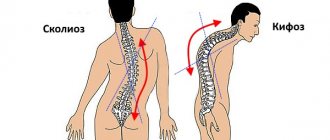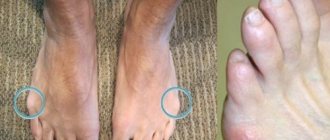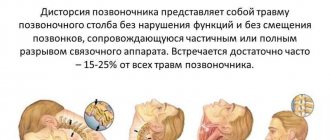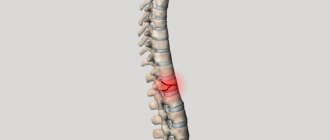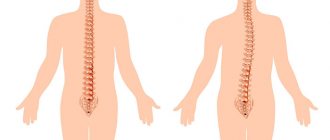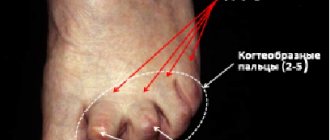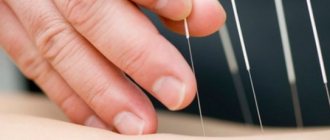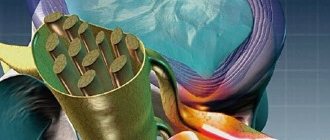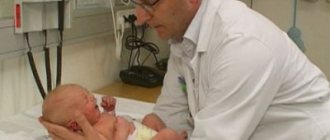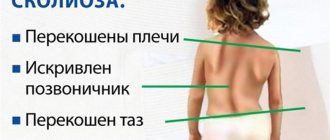How the spine is formed
The spine consists of the cervical, thoracic, lumbar, sacral and coccyx regions. Thus, it is a shock absorber that dampens vibrations during walking and protects the brain from them. In an adult, it reaches 43–45 cm and develops until 20–25 years of age.
It is believed that a healthy back is a straight back. In fact, the normal shape of the spine is an elongated letter S. It is very important to take care of the development of this important part of the skeleton in the first year of the baby’s life.
1) First bend. When a baby is born, his back is curved in the shape of the letter C. He does not yet know how to straighten his neck and hold his head, so your help is constantly needed here. You may notice that when your newborn baby lies on his stomach or when you pick him up, he lifts his legs, knees bent and spread. So his spine takes the same rounded position to which he was accustomed before birth. He feels a release of tension from his back and hips. In this position, the baby feels calmer, digests food better and spends less energy.
2) Cervical bend. A few months after birth, the child learns to raise his head and turn it towards noise or light. This is how the muscles that support the cervical spine develop, and the second, cervical, curve is formed.
How to promote the development of the cervical curve of the spine
Now you need to allow the baby to be in a position lying on his stomach as much as he wants. Just don’t forget that what he’s most interested in is communication—don’t leave him alone for a long time. Sure, a mirror or toy will keep him entertained for a while, but if you don't show up to interact with him, he may start crying and getting angry. Here's how to organize your baby's time as he learns to hold his head up while lying on his tummy:
- put it on your stomach when the baby is full, has slept, has a lot of strength and is in a good mood;
- undress him and leave him in one diaper or without it, so that it is easier for the child to grab everything with his hands and hold on with his legs;
- put him on a hard surface so that it is easier for him to push off from it;
- make sure the surface is warm and comfortable;
- you can lie down next to the baby so that he feels that you are nearby and ready to communicate with him;
- Sing him a song, read a book, and otherwise create a positive emotional connection with tummy time;
- Let your baby lie on his stomach every day for 30 minutes. This period can be “broken” by letting him stay in this position for 5 – 10 minutes at a time.
3) Lumbar curve. It is formed as soon as the child begins to crawl. By 12–18 months, when the baby learns to stand, the development of this curve will be completed and correct posture will be formed.
Now it is important to create conditions in which the baby can be on his stomach, as well as leaning on his arms and bent knees for as long as he needs: to play, crawl and just stand.
4) Sacral kyphosis (curvature) is formed when the child actively walks, by the age of 6–8 years.
How not to harm a child during the formation of the spine
Do not try to rush your child through all stages of his spinal development.
1. If you leave your baby in small playpens or with toys that make it difficult to move, or place him in such a way that he cannot try to move on his own, this will cause the spine to form more slowly. More serious problems may also arise.
2. Be extremely careful when using various devices. Rockers for rocking a newborn allow the baby to remain in the same position in the womb for too long and do not promote the formation of healthy curves in the spine. If you don't lay him on his tummy, he doesn't have the opportunity to get stronger and develop the necessary muscles. If you do use various devices, limit the time you use them.
3. Choose kangaroo backpacks with a hard back.
4. Support your baby's head, back and buttocks while he is in your arms.
5. Use massage and gymnastics: this strengthens the muscles and promotes the development of the spine. We talk about this here and here.
6. Closer to 2 years, it’s time to think about buying special children’s furniture that will allow the baby to draw, sculpt and do other things while maintaining correct posture. It is worth taking special care that he does not play with the tablet while looking down at it: all such activities should not lead to the fact that the head is constantly in a bowed position, creating tension in the neck and back.
Problems with the spine and their elimination in childhood
Very often, children who have disorders in the development of the spine sleep poorly, are capricious a lot, get tired quickly, fall and do not want to stand on their feet. Young mothers associate these problems with tummy troubles, childhood weakness and, sometimes, do not attach much importance, but this may be a signal of the beginning of the development of a serious problem. Pathological curvatures of the spinal column affect the function of the spinal cord: hence headaches, fatigue, pain in the back and lower extremities, problems with vision, digestion and a number of other unpleasant symptoms that accompany diseases of the main organs.
The correct development of a child's spine is a guarantee of beauty and health in the future. Torticollis, uneven length of legs, stoop and everything that can later cause not only illness, but also external deformity - all this can be prevented and corrected in infancy, it is only necessary to undergo preventive examinations of the baby in a timely manner. All these problems can be easily eliminated with a well-chosen course of therapy; doctors from the Happy children's clinic recommend:
- therapeutic massages;
- special exercises (even very young children need them to strengthen the muscular corset that supports the spine);
- in difficult cases, wearing various orthopedic pads that will quickly help eliminate deviations.
Don't try to speed up spinal development milestones
1) You can’t drop your baby off when he’s not ready for it.
If a child is seated, despite the fact that the necessary neck muscles have not yet become stronger, the spine takes on the weight of the head. For him, such a load is too heavy, and it can damage him and prevent his internal organs from developing normally. Therefore, jumpers and other similar devices should be used no earlier than the baby learns to sit independently. But even then, the child should be placed in them in very measured doses, since they limit freedom of movement. He still needs to develop various muscles, including his abdominal muscles, which help him crawl and then learn to walk.
As a rule, the baby is ready to learn to sit at 6–7 months. But 5 is still early.
2) Do not try to put the baby on his feet by holding him by the arms if he is not yet ready.
You can do this only when the baby has learned to stand up on his own.
Clinical case
What does this look like in practice? As an example, consider a clinical case of a child with thoracolumbar kyphosis. Age – 1 year, weight is below normal (8.5 kg). He developed mentally and physically in accordance with age standards: he began to hold his head up, sit down, and walk on time. Upon examination, attention is drawn to thoracolumbar kyphosis, the spinous processes of the thoracic and lumbar vertebrae form a convex posterior arch. History: pregnancy was threatened with termination in the 1st and 3rd trimesters, the child was born premature, and suffered from pneumonia in infancy. He was also diagnosed with complex combined heart disease. Low weight from birth. Burps after every feeding, often belching air. Considering the problems with the visceral organs, the osteopath’s work during the treatment session was aimed at relaxing the thoraco-abdominal diaphragm, and work was also carried out with the mediastinal organs - the pericardium and esophagus. Using gentle visceral techniques, the doctor relaxed the ligaments that pass from the internal organs to the diaphragm. In addition, work was carried out on the abdominal organs - the stomach and intestines. The main goal was to mobilize these organs, improve their motility and mobility, give them greater mobility and relax tense ligaments. Recommendations were also given for further diagnostic examination and resolving the issue of surgical removal of the heart defect.
Body position of a newborn baby: vertical or horizontal?
What is better: to carry your baby in your arms, holding him in an upright position, or to carry him in a stroller, where he lies on his back? The first is preferable, since in the latter case the back remains in the same position in the shape of the letter C and the spine does not develop, muscle tone decreases.
Of course, you can push your baby in a stroller to the desired location, but in reality, many parents only hold their baby for a couple of hours a day, and the rest of the time he lies on his back in a crib or in his “personal vehicle.”
Here are other benefits of standing upright for babies during the day.
- The risk of developing ear infections is reduced: they appear due to the fact that when the baby is most often in a horizontal position, mucus is not removed in the nasopharynx and enters the middle ear, causing inflammation and otitis media.
- The vestibular apparatus develops: the baby moves with the parent.
- The child feels safe.
- He learns faster because he sees more objects and hears more sounds.
It is harmful for babies to remain in a car seat or carrier for more than two hours: their spine needs to develop, and this does not happen in the letter C position.
Stages of scoliosis
The disease is classified into four degrees of severity. The first, as is clear, is the easiest. This diagnosis is made when the spinal column deviates from the norm by no more than ten degrees. What are the first degree symptoms? There are quite a lot of them, so we will list the main ones:
- head slightly lowered;
- shoulders pulled together;
- one shoulder is higher than the other;
- there is asymmetry of the waist
- there is an arc that is formed at the moment when a person leans forward (in a straightened state it is invisible).
The second degree is diagnosed only if a person has had an x-ray and his spine deviates from the norm by 11-25 degrees. The signs are:
- neck asymmetry is observed;
- the pelvis is unevenly located, in addition, on the side on which there is a curvature, it is lowered;
- there is a cushion on the lumbar region;
- chest sticks out.
And, most importantly, in the second degree of the disease, the arc is observed not only when tilted - it is visible even when the person is in an upright position.
The third degree is diagnosed when the spine deviates from the norm by 26-50 degrees. In this case, the disease is visible to the naked eye, since a person has a rib hump on the side of the curvature, and on the other side the ribs are sunken. The patient literally becomes distorted. Also, the ribs, located on the side on which the arch is skewed, are close to the largest of the three paired bones that form the pelvic bone.
The fourth stage is diagnosed when the deviation of the angle of inclination from the norm is at least 50 degrees. The human ribs, located in the place where the bend is observed, fall on each other. On the opposite side there are very tight muscles and a stretched space between the ribs.
As you can see, the most severe degrees are the third and fourth. If you don’t do anything to correct the situation, start treatment and follow the recommendations of specialists, you can remain immobilized. And at this time the disease will progress, and rapidly. As a result, the functioning of vital organs such as the heart, lungs, and pelvis will be impaired. As a result, the person will become disabled.
This is how a seemingly harmless disease can lead to such serious consequences. So treatment of scoliosis in children is a necessary measure that every parent whose child suffers from this disease should take. Under no circumstances should you turn a blind eye to this and regularly visit a doctor for examinations.
The shape of the curvature may vary. It doesn’t matter what the degree of scoliosis is: it can be arched in the shape of the letter C, it can have two arches (in the shape of S), and also with three or more arches, resembling the letter E.
Sleep and child health
When choosing a mattress for a child’s crib, you need to think not only about the baby’s health, but also about his safety. Sleeping on the stomach, an overly soft bed, warm clothing that is inappropriate for the weather, and wrapping the baby too tightly - all these factors are associated with SIDS - sudden infant death syndrome, which threatens infants. There is no need to be overly nervous, but you should take care to follow safety rules. So, what's important to consider?
- Place your baby to sleep on his back, but not on his stomach or side.
- It is necessary to choose a hard mattress that is precisely sized to fit the crib, stroller or playpen.
- It is worth leaving the baby's crib in the parents' room at night so that the baby and mom and dad feel calmer.
- During the day, do not let your child sleep on pillows, sofas or other soft surfaces.
- Do not put a lot of warm clothes on your child.
- Do not cover the baby in a crib or stroller above the middle of the body, especially not over the head. Choose only very thin blankets. Up to 2 years, it is better not to use them at all and buy special clothes for sleeping.
- Remove toys and other unnecessary items from the crib while your baby is sleeping.
- The same applies to things or clothes that the baby can pull off.
- Do not leave your baby to sleep in a car seat or other crib that is not intended for sleep.
- Until 1.5 - 2 years old, do not allow your baby to sleep with a pillow.
- The soft side inserts in the crib must be removed when the baby has learned to stand, otherwise he will try to get out of there and may get confused, which can lead to injury.
Between 18 and 36 months, babies can be transferred to a regular baby bed.
- The mattress should not be too hard and not too soft.
- Choose a mattress with safe hypoallergenic filling.
- Linen must be changed weekly.
- Change the mattress every 3 years up to 10 years: they wear out and no longer provide full support to the spine.
Preparing the place, ourselves and the child
Children's massage for scoliosis is carried out an hour after eating. To carry out the procedure, choose a flat and hard surface. If the child is small, then the massage is performed on a large, stable table. In this case, the adult should have the opportunity to be both to the right and to the left of the child.
If the child is tall, then the place of massage may be the floor in the middle of the room.
The massage area is covered with a blanket and a clean sheet.
The massage therapist's hands should be clean and dry.
The child is placed on his stomach with his arms bent at the elbows and hands at the shoulders. The body is given the position in which the spine is in the most correct position. Shoulders are placed at the same level.
The position of the body does not change during the session. The hands of an adult and the body of a child are lubricated with baby oil intended for skin care.
What is flat feet in children
Until the age of 3 years, a child’s foot is flat, which is called “physiological flatfoot.” This is normal: at this stage, fat pads make the feet plump and flat in appearance. After 3 years, it is important to select shoes for your child and monitor his harmonious physical development.
- The formation of the foot occurs before the age of 14. Until about 6 months, the baby has no hard bones there, only soft cartilage; By the time of the first steps, about 25 bones are formed in the feet, which continue to grow and develop. It is very important that the baby’s legs are not subjected to prolonged compression, which can displace the developing bones.
- Flat feet in children develop when the arches of the feet drop. The cause may be a weak muscle system, which is caused by diseases or improper physical activity, incorrectly selected shoes, injuries or heredity. As a result, the depreciation of the feet changes, the load on the spine and legs increases, which can harm the joints.
How to find out if a child has flat feet
It is worth contacting an orthopedist if the child refuses to run, complains of pain in the legs, gets tired quickly, if his gait changes.
Correctly and promptly selected shoes can prevent many orthopedic problems and flat feet in children.
Causes of pathology
Lordosis in children has special causes. Treatment begins with determining the mechanisms that trigger the disease. Some of these mechanisms are innate. Pathological lordosis begins due to a number of reasons.
Past infectious diseases
Infectious diseases of the mother can cause lordosis in the child. Therefore, during pregnancy, it is important to avoid crowds of people during epidemics and to take every possible precaution against infection with bacteria and viruses.
Injuries during pregnancy or childbirth
Injuries during pregnancy or childbirth trigger the development of lordosis. Injuries during the passage of the birth canal interfere with the correct formation of the spine. In many cases, the consequences of birth trauma appear many years later, when the child enters adolescence.
Violation of the reproductive organs
In some cases, the structure of the genital organs of the expectant mother compresses the child’s body at birth, causing developmental disorders. At the same time, the mother herself suffers from changes in the curvature of the spine.
Prevention and treatment of flat feet
As a rule, the doctor recommends physical exercise to the child - for example, skiing and cycling, massage, and wearing orthopedic shoes.
- It is not recommended to walk on rocky places and hard ground without shoes for a long time - it is better for the baby to stomp his bare feet on sand and loose soil.
- It is harmful to wear warm shoes indoors, carry heavy objects, and stand without moving for too long.
The first shoes for healthy feet
Most pediatricians agree that before the baby begins to take his first steps, he does not need shoes. Of course, in cold winter it is necessary to protect the child’s feet: choose soft boots in which the foot will rest freely and the baby will be able to move his toes. Do not wear tight socks on him: even wearing them can lead to crooked toes.
The diagnosis of hallux valgus can only be made after 3 to 5 years. With this disease, there is curvature of the phalanx of the big toes, which affects gait, posture and often leads to complications. Hallux valgus deformity can appear in children who already suffer from transverse flat feet, have had little physical development, have worn incorrectly selected shoes, or have genetic or endocrine disorders. But this condition can be successfully corrected if you see a doctor in time.
Treatment for lordosis
Treatment of lordosis in children is carried out after determining the causes and diagnosing the stage of the pathology. The doctor first collects anamnesis, examines the little patient and prescribes the necessary tests. During the examination, it is important to evaluate how the child stands and what his posture is. In some cases, tests are done to see if there are neurological problems. In addition, the doctor palpates the back muscles. At the first stage, the following stabilization methods are used:
- massage;
- Healing Fitness;
- wearing a corset;
- In case of complications, drug treatment is used.
The use of physiotherapy has a positive effect: hydrotherapy, treatment with magnets. Surgery is recommended only in the most difficult cases, when the curvature significantly reduces the patient’s quality of life.
When does a child start walking?
The gait of a child under 4 years old is very different from the gait of an adult. And the foot itself is designed differently.
- You should not buy special corrective shoes without consulting your doctor: excessive arch support can cause the leg muscles to develop incorrectly.
- A variety of sensory experiences is the key to harmonious development. This also applies to introducing the baby to various surfaces on which he needs to be allowed to walk: the floor, earth, sand, grass, stones, logs, etc. Massage mats and simple exercises for the correct formation of the arch of the foot are perfect for the home: rolling on the floor sticks, drawing shapes with feet, grabbing objects with toes, rolling from toe to heel, etc.
- Shoes must “breathe”. It can be made of textiles, leather or a special membrane, but rubber boots are recommended to be worn only for short periods of time.
- The first shoe should definitely provide ankle support, but should not be too tight. Therefore, try not to lace your shoes too tightly: there should be free space between the child’s foot and the surface of the shoe.
- The sole - even of winter shoes - must bend. A sole that is too hard can also lead to flat feet.
- Remember that it is advisable to buy shoes in a fitting store in the afternoon. At this time of day, a child’s legs often swell and increase in size (especially in hot weather). In the future, you will have to check at least once a month whether the shoes are spacious enough, because the baby is growing quickly. Such checks also need to be carried out in the afternoon. Let us immediately warn you that the child “grows out” of the first shoes in about 3 to 6 months.
If the described requirements are met, you don’t have to worry that the shoes will lead to flat feet in the child - in a healthy leg, problems will not appear only from external factors. If close relatives often have similar problems, the likelihood of them occurring in your baby also increases, and in this case additional measures are necessary: shoes with arch supports and special physical exercises. This will not eliminate the problem, but it will help prevent it from becoming more pronounced.
- Thin leather or fabric is the best material for the top of children's shoes.
- Flexible, fairly hard, moderately thin and non-slip sole.
- Put the shoes on your baby and let him stand in them for a while. Then check how they fit: an adult's little toe should fit easily between the heel and heel, and there should be about one centimeter of free space in the front. Attention! You need to measure this centimeter from the baby’s longest finger, and this is not always the big one.
- Shoes must fit not only in length, but also in width. Babies' feet are usually chubby, and this must be taken into account. Try squeezing the surface of the shoe over your foot. It should wrinkle easily. If this does not happen, the shoes fit too tightly on the child's feet.
- Ask your child to walk around the store in new shoes for some time (ideally 15 to 20 minutes), and then carefully examine the feet. The slightest redness of the skin in places of contact with the shoes is a clear signal that the new thing will rub the foot, and you should not buy it.
- Make a choice: laces or Velcro. Remember that the baby will very quickly understand how Velcro works and will take off his shoes himself when necessary and not necessary.
We wish your baby health!
Disease prevention
To prevent a disease, you need to eliminate the factors that cause it. Prevention of the disease is simple and consists of the following steps:
- Pregnant women need to wear a bandage. This is necessary to prevent modification of the reproductive organs and prevent lordosis.
- Children and students need to properly organize their workplace and maintain good posture.
- Active people should avoid excessive physical activity and avoid overstressing their back.
- Children need to have an annual examination.
- Parents should monitor whether the child has correct posture when he is walking or doing homework at home.
- It is necessary to instill in your child the habit of doing morning exercises or introduce other moderate physical activity into his daily routine.
- Do not allow your child to overeat and become overweight.

